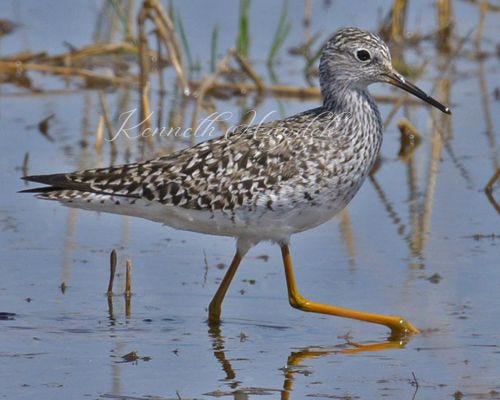March: Lesser Yellowlegs
As their name suggests, lesser yellowlegs have, well, yellow legs. These bright yellow legs give them a high step and graceful gait as they walk through shallow waters where they are often found. In relation to greater yellowlegs, lesser yellowlegs are shorter and more slender, with “needlelike” bills that are thinner, shorter, and straighter. Otherwise, the two birds look nearly identical, although they can be differentiated by call.
In breeding season, lesser yellowlegs have gray-brown heads and bodies with white and black streaking and mottling. Their underparts are white with some brown streaking. In nonbreeding season, they are more solid gray-brown, with some pale spots.
Lesser yellowlegs are medium- to long-distance migrant shorebirds. They can fly upwards of 45 miles per hour and can also swim. Summer breeding season finds them in woodland clearings near water in Canada and Alaska’s boreal forest. During their migrations, they seek out salt- or fresh-water marshes, mudflats, slough, ponds, estuaries, and shorelines.
Fall migration may begin as early as July, and many of them travel along the eastern coast of the of the U.S. to winter in Florida, Mexico, Central, or South America. Spring migration starts around February and finds them moving northward again, usually west of the Mississippi River.
Lesser yellowlegs glean insects from shore or forage for them in shallow water (occasionally going out further into waters as high as their belly) along with larvae, snails, small fish, and worms. Interestingly, downy young feed themselves, while they are brought food from their parents, often the male parent. Females tend to vacate nests early, leaving males to defend them.
Lesser yellowlegs are preyed upon by avian predators, such as owls, hawks, and falcons, as well as snapping turtles, cats, coyotes, and red foxes. Lesser yellowlegs will try to lure predators away from their nests with flashy displays, but they are known for being stalwart defenders of their territory during breeding season. Both males and females are recognized for their “tu-tu” call, but they will also make a sharp “kip” and bob their heads when alarmed.
Adults will attack potential predators of eggs and nestlings, including sandhill cranes and bald eagles. They will also join forces—alerting one another to danger by hovering and calling—to mob a predator. Nesting adults will stay put until a predator has been driven no less than a mile away.
Eager to catch a glimpse of those famous yellow legs? You will likely be most successful to find them during their migrations. Check out this eBird animated map to get an idea of when lesser yellowlegs may be approaching some pleasant shore near you.
Sources:
https://www.allaboutbirds.org/guide/Lesser_Yellowlegs/
https://www.audubon.org/field-guide/bird/lesser-yellowlegs
https://www.adfg.alaska.gov/index.cfm?adfg=wildlifediversity.projects&project=lesser-yellowlegs
https://animaldiversity.org/accounts/Tringa_flavipes/
https://www.fws.gov/species/lesser-yellowlegs-tringa-flavipes



